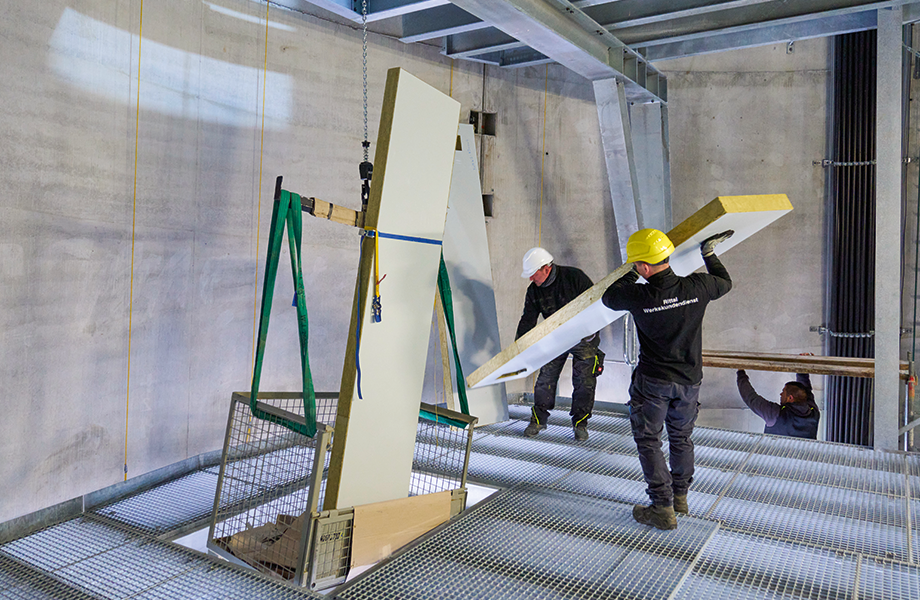Text David Schahinian ––– Photography
The idea is a simple one – using electricity where it is being produced on a climate-neutral basis anyway, in the actual wind turbine. What started as an experimental project over ten years ago has, for some time now, been suitable for use on an industrial scale under the windCORES brand.
The successful upscaling of the project was by no means an easy task. Although utilising the existing wind turbine infrastructure and installing racks sounds simple, there are limiting factors. Besides structural, safety and fire load considerations, for instance, the confined space also needs to be taken into account. In collaboration with Rittal, WestfalenWIND IT developed a three-level model for building a multi-storey data centre in the bottom part of a turbine tower. This significantly increases the profitability for each wind turbine. There is also good scope when it comes to fitting out the racks.
“LIKE A SHIP IN A BOTTLE”
You don’t get very far with just a concept, though. A great deal of preliminary planning was required before putting the idea into practice. “It was a real challenge, like a ship in a bottle, because all the technical equipment needed to fit through a small entrance,” explains Dr Fiete Dubberke, Managing Director of WestfalenWIND IT.
“Energy-efficient data centre operation has long been a focal point for us, so it made sense for us to collaborate with a producer of low-cost, sustainable electricity. It’s a classic win-win situation that manifests itself in our shared creative drive. We don’t look for problems, we solve them,” adds Michael Nicolai, Head of Rittal IT Sales in Germany.
A data centre’s power supply and grid connection are its lifelines. In the case of windCORES, the former is quite literally close at hand. The electricity comes directly from the wind turbine’s generator – during 90 percent of the year, at least. The rest of the time, it has to be obtained from the public grid. To ensure a high-quality power supply at all times, WestfalenWIND IT works with two different grid operators. In many applications, the timing of high computing loads can be controlled to coincide with windy periods. This means the data centre can be operated almost entirely using renewable power. WestfalenWIND IT also takes a doubled-up approach when it comes to grid connection. Two backbone connections ensure redundant data highways to the DE-CIX Internet hub in Frankfurt. “Our infrastructure benefits from very low latency and a high-performance bandwidth,” emphasises Dubberke.
STEEP LEARNING CURVE
Technical implementation aside, there was a further initial challenge to be met. It took a while to obtain all the necessary approvals for the first windCORES installation in the Paderborn district, but windCORES II has now been commissioned in Lichtenau, in the North Rhine-Westphalia region of Germany. The data centre will carry out high-performance computing (HPC) for AI as well as simulations for autonomous driving. While the infrastructure – security rooms, IT racks and climate control, for example – is supplied by Rittal, WestfalenWIND IT acts as a provider of sustainable IaaS, including complete cloud solutions.
Infrastructure is an important criterion in all economic efficiency calculations. It is clear that demand for computing capacity has been growing strongly for a number of years and that this trend will continue as a result of new technologies. However, it is sometimes hard to keep up with these requirements. In some cases, it can take years to build a conventional data centre – not to mention the additional land that is used up. Wind turbines are already built. “Although they are relatively small units, currently providing up to 1 megawatt of IT power, the infrastructure is in place and is available almost immediately. This offers true added value for the data centre market,” emphasises Dubberke. The number of wind turbine towers suitable for turning into data centres in Germany runs into four figures, and it goes without saying that they are an eye-catching option. With a little flexibility, however, there are also other ways in which eco-friendly electricity can be used as close as possible to the point where it is generated. This is because WestfalenWIND IT invested massively in the entire power generation and transmission chain at an early stage. For example, Dubberke also considers container solutions at a wind turbine or one of the company’s transformer substations to be a suitable alternative if the turbine tower itself is not an option. In the Paderborn district alone, substations with a total capacity of around 450 megawatts are available. Whatever option is used, there must be no compromises when it comes to safety. All the necessary precautions and measures are verified, as in any other data centre, and an additional goal of obtaining TIER 3 certification has been set.
SEEING IS BELIEVING
WestfalenWIND IT is now looking to win new customers for its innovative data centres. “On paper, many may still have their doubts, but anyone who has visited an actual installation is normally won over very quickly,” reports Dubberke. The company is also intending to develop the concept further. Whereas work to date has largely taken place on an equity-financed basis, a three-year research project benefiting from a total of around 2.5 million euros in German government funding started in 2023. As part of this project, a consortium is looking to develop the infrastructure and management framework for an HPC cluster covering several wind turbines.
The current market is now such that windCORES can power ahead. The intelligent use of existing infrastructure with energy produced on a climate-neutral basis constitutes a marketable and scalable alternative. “There’s a right time for every new technology, and that is now,” says Nicolai confidently.






